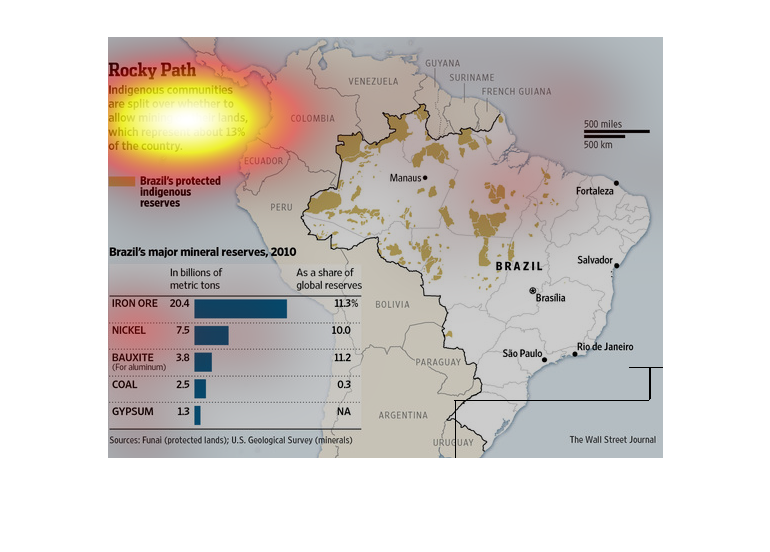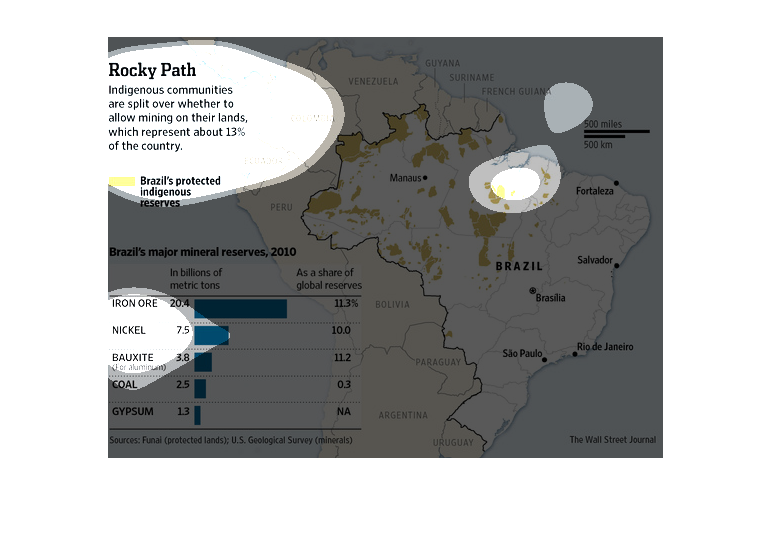
This chart describes rocky path. Specifically, indigenous communities are split over whether
to allow mining on their lands, which represent about 13% of the country.


The following chart shows how indigenous groups in Africa are split on whether of not to allow
mining on their lands. These lands make up about 13% of the total land of the country.


This is a map and a bar chart that describe the minerals that are found and mined in Brazil.
The map shows the locations of deposits and the chart details the quantities of various minerals
that are miend.


The following chart is titles Rocky Path, it discusses how the different indigenous groups
in Brazil are undecided on weather or not to allow mining on their lands.


This info graphic shows that indigenous communities are split over whether to allow mining
on their lands which represent about 13% of the country. Brazil has protected indigenous reserves
all through the country but they are especially located in the northern region. The major
mineral reserves in Brazil are iron ore, nickel, and bauxite.


This chart shows a map of the Indigenous Reserves in Brazil and a chart of Brazil's major
mineral reserves. Indigenous land makes up 13% of the country. Iron Ore in Brazil accounts
for 11.3% of the global reserve.


This chart describes rocky path. Specifically, indigenous communities are split over whether
to allow mining on their land, which represent about 13% of the country.


Indigenous communities in Brazil are split over the decision of whether or not to allow mining
on their land. Brazil's mineral reserves are large and as of 2010, iron ore was the largest
with 20.4 billion metric tons.


This chart illustrates how indigenous people are split around whether to allow mining on their
land. It shows Brazil's major mineral reserves in 2010 with iron ore being at the top of
the list.


This is a series of maps and graphs depicting South America and it's indigenous populations
opinions on whether to allow mining on their lands, which represent about 13% of the country.


The image is titled "Rocky Path", and depicts Brazil's Major Mineral reserves in 2010. The
areas that are highlighted indicate protected indigenous reserves, which are primarily located
around the outer states.


This image shows a visual representation of South America and its various mineral reserves.
It appears that Iron Ore is the largest mineral reserve. These reserves are indigenous.


Indigenous cultures in South America are split over whether mining should be allowed on native
lands. Brazil, in particular, has billions of metric tons of metals, such as iron and nickel,
on native reserves.


The graph represent the major mineral resources reserved by the indigenous communities. Indifenous
communities are split over whether to allow mining on their land which represent about 13%
of the country. Iron is the major mineral resource in Brazil which is 20.4 metric ton and
11.3% as of share of global reserves. Brazil also have a reserve for Nickel, Bauxite, coal
and gypsum which account for 7.5, 3.8, 2.5 and 1.4 billion of metric ton. Data is provided
by Funal : Protected land U.S Geological source


Indigenous community in south america are split over whether to allow mining in their land.
!3% of the land in Brazil are part of indigenous reserve. There are several valuable minerals
in these lands.
































